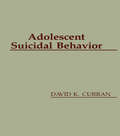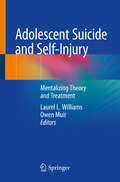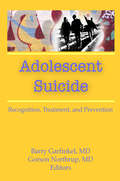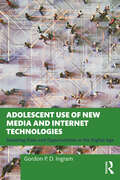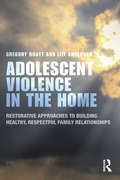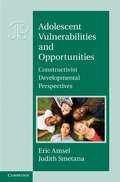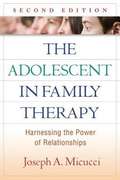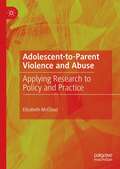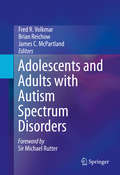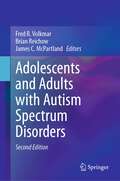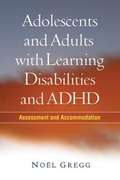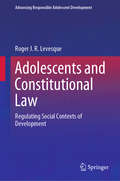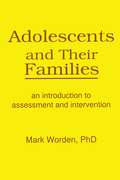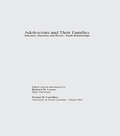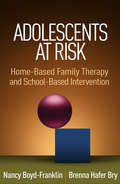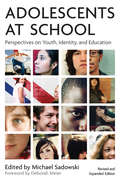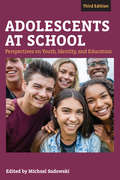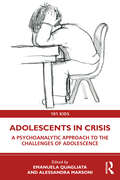- Table View
- List View
Adolescent Substance Abuse: Psychiatric Comorbidity and High Risk Behaviors
by Yifrah KaminerLearn more effective treatments for adolescents with abuse substance disorder Dual diagnosis of adolescent substance use disorders and comorbid psychiatric disorders must be treated simultaneously to be effective. Adolescent Substance Abuse: Psychiatric Comorbidity and High Risk Behaviors presents leading experts offering insightful viewpoints and dynamic suggestions on how to best provide simultaneous treatment and integrated services to these youths. The book covers the state of the art in the field of substance use disorders, and reviews different psychiatric disorders and high risk behaviors, and then addresses the issue of integrated services and ethical, legal, and policy issues pertaining to this population. In the field of adolescent substance abuse treatment, dual diagnosis is the rule rather than the exception, making assessment and treatment complicated. Adolescent Substance Abuse: Psychiatric Comorbidity and High Risk Behaviors comprehensively discusses the magnitude, etiology, and characteristics of problems and substance abuse disorders (SUD), and extensively explains ways to assess, treat, and develop services for adolescents. This unique text closely examines the assessment and treatment of psychiatric comorbid disorders among adolescents such as depression, anxiety disorders, ADHD, and high risk behaviors including suicidal behavior, self-harm behavior, and gambling behavior. The text is extensively referenced and several chapters include helpful tables and figures to clearly display the data. Topics examined in Adolescent Substance Abuse: Psychiatric Comorbidity and High Risk Behaviors include: etiology of adolescent substance abuse assessment treatment planning psychosocial interventions pharmacological interventions disruptive behavior disorders attention deficit hyperactivity disorder depression bi-polar mood disorder anxiety disorders trauma and post traumatic stress disorder (PTSD) suicidal and self-harm behaviors schizophrenia eating disorder gambling behavior Adolescent Substance Abuse: Psychiatric Comorbidity and High Risk Behaviors is an invaluable resource for mental health professionals, pediatricians, family physicians, nurses, addictions specialists, counselors, educators, students, and drug court professionals who provide assessment and treatment for youths with substance use disorders.
Adolescent Suicidal Behavior (Series in Death, Dying, and Bereavement)
by David K. CurranFirst published in 1987. Routledge is an imprint of Taylor & Francis, an informa company.
Adolescent Suicide and Self-Injury: Mentalizing Theory and Treatment
by Laurel L. Williams Owen MuirThis volume presents a comprehensive and practical approach to the treatment of suicide and NSSI for adolescents utilizing a mentalizing framework. The beginning of the text provides up-to-date information on the theory of a mentalizing therapy in order to ground the readers in the neuroscientific underpinnings of a mentalizing approach. Next chapters provide information on the fundamental building blocks of a mentalizing therapy at the individual and family level. These chapters provide step-by-step approaches in order to provide examples of the techniques involved in mentalizing treatment that can be employed to address suicidality and NSSI. The next chapter builds on these concepts as the reader learns about mentalizing failures involved in common co-morbidities in adolescents who are experiencing suicidality and/or employing NSSI. The next several chapters cover practical issues related to working within this patient population including the key concept of social systems and connections for both providers and adolescents, the ability of mentalizing theory and therapy to integrate with other effective therapies, how to approach sessions after a suicide attempt, resiliency for patient, family and the provider, along with important self-care for a therapist if a patient commits suicide. The final chapter brings all of the aforementioned elements together in order for the reader to conceptualize employing a mentalizing approach to adolescents and their families when suicide and NSSI concerns are a predominate focus of care. Illustrations of specific therapeutic approaches and a list of resources and guidelines where available are also included.Adolescent Suicide and Self-Injury is an excellent resource for all clinicians working with youths at risk for suicide and/or self-injury, including psychiatrists, psychologists, pediatricians, family medicine physicians, emergency medicine specialists, social workers, and all others.
Adolescent Suicide: Recognition, Treatment, and Prevention
by Barry GarfinkelInform yourself with thorough and accurate knowledge about the incidence of adolescent suicide. Adolescent Suicide serves to correct erroneous conceptions--held by the public and professionals--about the nature of suicidal behavior among the young, thereby promoting the opportunity for more prompt and effective evaluation and management of potentially fatal incidents. In this landmark volume, authorities address the problem of suicide among adolescents, which has emerged in recent years as a significant public health problem. In-depth discussions of the epidemiology and behavioral characteristics of youth who attempt and complete suicide, risk factors, methods of death, circumstances of the suicidal act, and reasons for the dramatic increase in the phenomenon provide social workers, educators, psychologists, and psychiatrists with systematic information that can be used in both prevention and intervention efforts. There is also a wealth of valuable material here on school-based suicide prevention programs, strategies for managing and counseling the relatives, peers, and classmates of individuals who have committed suicide, and coping with suicide in residential treatment centers.
Adolescent Therapy that Really Works: Helping Kids Who Never Asked for Help in the First Place
by Janet Sasson EdgetteEdgette proposes a unique approach to relating to adolescents in therapy. Focusing on establishing genuine and unaffected relationships between therapists and teens, this book offers techniques for clinicians who want to engage and connect with their adolescent clients. The goal is to bring about conversations that are candid and therapeutically effective so that teens and their families can find dignified and durable solutions to their problems. Case examples and stories from Edgette’s own practice illustrate how therapists can successfully navigate difficult encounters, avert power struggles, and avoid dead-end dialogues that bore teenage clients and stall treatment. Thorough and lucidly written, Adolescent Therapy That Really Works shows therapist how to become partners with their clients, maintain their authority while also drawing teens into comfortable conversation, and read body language and facial expressions to better convey understanding and respect. Every therapist who works with adolescents and their families will benefit from the wisdom, skill, and honesty exhibited in Edgette’s therapeutic approach.
Adolescent Use of New Media and Internet Technologies: Debating Risks and Opportunities in the Digital Age
by Gordon P. IngramThis book engages with contemporary, and often polarizing, debates surrounding the risks of adolescent use of digital media and internet technologies. By drawing on multiple research studies, the text synthesizes current understandings of the impacts of social network use, online gaming, pornography, and phenomena, including cyberbullying, cyberstalking, and internet addiction, to develop recommendations for the effective identification of at-risk youth, as well as strategies for informed communication about online risks and opportunities. It shows how media discussion of risks to children and teenagers from new technology is highly emotive and often exaggerated, rooted in the “moral panic” surrounding new cultural practices that young people engage in, but which adults do not understand. Online risks are thus conceptualized as centering on three areas, specific to adolescence, which have undergone radical changes due to new internet technology. These include young people’s identity, the types of content that are accessed, and social relationships. The author shows how these matters stem from the potential of new technology to establish new interpersonal connections, emphasizing how it brings opportunities, as much as risks. As such, he provides a uniquely balanced discussion of potential dangers, while also emphasizing the opportunities for social, academic, and personal growth which new technologies afford young people. It will be indispensable for researchers and clinicians interested in assessing levels of online risk, as well as scholars and educators with interests in cyberpsychology, social psychology, cyber culture, social aspects of computing and media, and adolescent development.
Adolescent Violence in the Home: Restorative Approaches to Building Healthy, Respectful Family Relationships
by Lily Anderson Gregory RouttAdolescent Violence in the Home examines a form of violence that has a profound impact on families but is often overlooked and frequently misunderstood: teen aggression and violence toward members of their family—especially parents. Violence in adolescents is often seen as the result of a mental-health diagnosis, delinquency, or as a response to dysfunctional parenting, and though understanding a youth’s mental-health status or a parenting style can be helpful, complete focus on either is misplaced. Adolescent Violence in the Home uses a restorative framework, developed by the authors and in use in court systems and organizations around the world, to situate violent behaviors in the context of power and the intergenerational cycle of violence. Readers will come away from this book with a profound understanding of the social and individual factors that lead youth to use violence and how adolescent violence affects parents, and they’ll also learn about a variety of interventions that specifically address teen violence against parents.
Adolescent Vulnerabilities and Opportunities
by Judith Smetana Eric AmselThis book explores the central importance of adolescents' own activities in their development. This focus harkens back to Jean Piaget's genetic epistemology and provides a theoretically coherent vision of what makes adolescence a distinctive period of development, with unique opportunities and vulnerabilities. An interdisciplinary and international group of contributors explore how adolescents integrate neurological, cognitive, personal, interpersonal and social systems aspects of development into more organized systems.
Adolescent in Family Therapy, Second Edition
by Joseph Micucci Celia FalicovRich with clinical wisdom, this successful text and practitioner guide offers a comprehensive framework for treating adolescent problems in the family context. Even as teenagers become increasingly independent, Joseph Micucci shows, they still need parental guidance and nurturance. By strengthening family relationships, clinicians can alleviate symptoms and promote behavioral change. Vivid examples and session transcripts illustrate specific strategies for treating eating disorders, depression, anxiety, defiance, underachievement, and other frequently encountered challenges. Weaving together family therapy techniques with ideas from psychodynamic and cognitive-behavioral approaches, the book has a pragmatic focus on effective interventions for getting adolescent development back on track. New to This Edition Thoroughly updated to reflect current research and reader feedback. Chapter on adolescent anxiety disorders. Expanded coverage of attachment issues; lesbian, gay, and bisexual youth; and racial and ethnic identity. New case material, one of the book's most popular features.
Adolescent-to-Parent Violence and Abuse: Applying Research to Policy and Practice
by Elizabeth McCloudThis book seeks to break new ground in the way in which adolescent-to-parent violence and abuse is understood. Incorporating knowledge from an original research project undertaken in the UK and international literature, this book provides insight into the prevalence of this form of domestic violence which can include psychological, physical, and economic abuse. Young person and family characteristics are explored, and links are made between sibling aggression and school bullying behaviours. A key theme is how the data can be used to develop statistical models which can screen for young people behaving abusively towards their parents. It discusses how the research can be applied to inform theoretical frameworks, policy development, and professional practice, with a focus on prevention and early intervention that uses positive youth justice and restorative approaches.
Adolescents and Adults with Autism Spectrum Disorders
by Fred R. Volkmar Brian Reichow James C. McpartlandThe research on children with autism spectrum disorders (ASD) is extensive and growing. Although these conditions are recognized as affecting the entire lifespan, the literature on ASD after childhood is limited and has not been brought together in a single volume in over a decade. Adolescents and Adults with Autism Spectrum Disorders fills this knowledge gap by focusing on needs and difficulties unique to these stages of development. Expert contributors offer cogent reviews of complex issues, from education to employment, leisure activities to illegal behaviors, mental health issues to medical health concerns. The latest findings in key areas, such as psychosocial and residential treatments, social skills programs, epidemiology, the impact of ASD on families, are examined in detail. Throughout the volume, coverage focuses on areas requiring improved models of assessment, updated data, new interventions and increased support services. Featured topics include: Transition from high school to adulthood for adolescents and young adults with ASD. Innovative programming to support college students with ASD. Romantic relationships, sexuality and ASD. Treatment of mental health comorbidities. Assessment and treatment planning in adults with ASD. The range of outcomes and challenges in middle and later life. Adolescents and Adults with Autism Spectrum Disorders is a must-have reference for a wide range of clinicians and practitioners - as well as researchers and graduate students - in clinical child, school and developmental psychology; child and adolescent psychiatry; social work; rehabilitation medicine/therapy; education and general practice/family medicine. It will also serve as an important resource for parents and caregivers with its focus on translating the current state of knowledge relevant to understanding adolescents and adults with ASD into practical and relevant recommendations on how best to support them.
Adolescents and Adults with Autism Spectrum Disorders
by Fred R. Volkmar Brian Reichow James C. McPartlandThe second edition of this book examines the numerous research and practice advances with regard to adolescents and adults with autism spectrum disorders (ASD). Expert contributors offer cogent reviews of complex issues, from education to employment, leisure activities to illegal behaviors, mental health issues to medical health concerns. The volume explores the latest findings in key areas, such as psychosocial and residential treatments, social skills programs, epidemiology, the impact of ASD on families. The book focuses on areas of research and practice that require improved models of assessment, current data, new interventions, and increased support services. Key areas of coverage include: Transition from high school to adulthood for adolescents and young adults with ASD. Innovative programming to support college students with ASD. Romantic relationships, sexuality and ASD. Treatment of mental health comorbidities. Assessment and treatment planning in adults with ASD. The range of outcomes and challenges in middle and later life for individuals with autism. The second edition of Adolescents and Adults with Autism Spectrum Disorders is a must-have reference for researchers, professors, and graduate students as well as clinicians, therapists, and other practitioners in clinical child, school, and developmental psychology, psychiatry, social work, rehabilitation medicine/therapy, special education, and general practice/family medicine.
Adolescents and Adults with Learning Disabilities and ADHD
by Noël GreggMost of the literature on learning disabilities and attention-deficit/hyperactivity disorder (ADHD) focuses on the needs of elementary school-age children, but older students with these conditions also require significant support. Comprehensive and authoritative, this book helps educators and clinicians navigate the maze of laws, policies, and scientific research relating to diagnostic and intervention decision making for adolescents and adults. Leading expert No\u00ebl Gregg provides clear guidance on how to conduct and document evidence-based assessments and select appropriate instructional and testing accommodations. Featuring helpful case vignettes, decision-making flowcharts, and coverage of the latest assistive technologies, the book gives special attention to supporting students during the crucial transition from high school to higher education or vocational settings.
Adolescents and Constitutional Law: Regulating Social Contexts of Development (Advancing Responsible Adolescent Development)
by Roger J. LevesqueThis textbook offers a foundation for understanding adolescents’ rights by articulating the complexity, breadth, and challenging nature of laws regulating adolescents. It showcases the Supreme Court’s key interpretations of the Constitution as it relates to adolescents’ rights. Chapters examine relevant legal systems and the social contexts that legal systems control. In addition, chapters discuss constitutional issues and their nuances through actual cases that often offer alternative interpretations of constitutional rules. The textbook guides readers through both well accepted and often ignored conceptions of adolescents’ rights. It offers readers unfamiliar with the law the tools they need to understand the importance of adolescents’ constitutional rights and how they can contribute to developing them. Topics featured in this text include: The role of parents and family systems in conceptualizing adolescents’ rights.The complexities of providing health care to adolescents.Religious freedom and adolescents’ rights relating to religion.The flaws of child welfare systems.The challenge of developing rights specifically for juveniles and delinquent youth.Juvenile court systems and the differential treatment of adolescents.The difference between the juvenile court system and the criminal court system.Adolescents’ media rights. Adolescents and Constitutional Law is an essential textbook for graduate students as well as a must-have reference for researchers/professors and related professionals in developmental psychology, juvenile justice/youth offending, social work, psychology and law, family studies, constitutional law, and other interrelated disciplines.
Adolescents and Their Families: An Introduction to Assessment and Intervention
by Mark Worden Terry S TrepperThis comprehensive book introduces and integrates adolescent developmental themes and family system theory into a coherent assessment and intervention model. Author Mark Worden views the adolescent as active in shaping the family interactions as much as the family is influential in shaping the adolescent’s behavior. He takes a pragmatic approach to therapy, emphasizing what best explains the clinical phenomena and what works best for change. To this end, a heavy emphasis is placed on the process of evaluation and intervention of adolescents and their families with typical therapeutic dilemmas. This practical book is organized to take the reader through the first evaluation interview, through the planning of intervention strategies, and through the beginning, middle, and termination phases of treatment. Case examples bring Adolescents and Their Families to life, highlighting conceptual discussions. Topics discussed in this important book range from the integration of adolescent and family psychology, to the employment of a contextual-dialectic (“goodness-of-fit”) paradigm to evaluate adolescent-family interface, to matching the intervention with the family. A step-by-step discussion of the first interview and diverse intervention strategies are discussed, as are frequent clinical syndromes--acting-out, underachievement, eating disorders, divorce/single parenthood, depression, and suicide. Graduate students and clinicians will find this appealing book an ideal resource, as will experienced therapists beginning to work with adolescents and families. The book will also serve as an excellent primary or ancillary text for graduate courses in psychotherapy with adolescents and in family therapy courses. High school guidance counselors, social workers, and psychologists will also find many valuable applications in this timely book.
Adolescents and Their Families: Structure, Function, and Parent-Youth Relations (Adolescence #4)
by Richard M. Lerner Domini R. CastellinoFirst published in 1999. The adolescent period is marked by changes in the biological, psychological, cognitive, and social dimensions of the individual, as well as by changes in the adolescents' multilevel context (i.e., the peers, family, school, and other institutions in his or her ecology). Adolescence is a dynamic period, one which exemplifies the importance of understanding the relations between the developing individual and his or her changing context. The articles included in this volume represent the current range of scholarship pertaining to adolescents and their families, and exemplify the use of such an approach. The articles underscore the continual importance of the family across adolescence.
Adolescents at Risk: Home-Based Family Therapy and School-Based Intervention
by Nancy Boyd-Franklin Brenna Hafer BryRich with illustrative case material, this book guides mental health professionals to break the cycle of at-risk behavior by engaging adolescents and their families in home, school, and community contexts. The authors explore the multigenerational patterns that shape the lives of poor and ethnic minority adolescents and present innovative strategies for intervening beyond the walls of the agency or clinic. Grounded in research, the book shows how to implement both home-based family therapy and school-based achievement mentoring to provide a comprehensive web of support. Building on the earlier Reaching Out in Family Therapy, this book reflects the ongoing development of the authors' multisystems approach and many other important changes in the field; the majority of the content is completely new. It is an indispensable resource for beginning and experienced professionals or text for courses on adolescent intervention or adolescent mental health.
Adolescents at School, Second Edition: Perspectives on Youth, Identity, and Education (Youth Development And Education Ser.)
by Michael SadowskiAs any teacher or parent knows, adolescence is a time when youth grapple with the question, &“Who am I?&” Issues of race, ethnicity, class, gender, sexual orientation, and ability can complicate this question for young people, affecting their schoolwork and their relationships with teachers, family, and peers. This new edition of Adolescents at School builds and expands the strengths and insights of the much-acclaimed first edition. Drawing from the perspectives of teachers, researchers, and administrators—and adolescents themselves—it examines the complex, changing identities young people manage while they confront the challenges of schools. A uniquely practical, insightful, and jargon-free volume, Adolescents at School points to ways to foster the success of every student in our schools and classrooms.
Adolescents at School, Third Edition: Perspectives on Youth, Identity, and Education (Youth Development and Education Series)
by Michael SadowskiAdolescents at School brings together the perspectives of scholars, educators, and researchers to address the many issues that affect adolescents&’ emerging identities, especially in relation to students&’ experience of and engagement with school. The book offers current and preservice teachers a practical understanding of the concept of identity development, particularly as impacted by such factors as race, ethnicity, gender, sexual orientation, ability/disability, immigration, and social class.This third edition includes new chapters on boys&’ emotional lives, risk and resilience in girls, the experiences of undocumented immigrant students, Muslim-American youth, and income inequality; features on &“teaching while white&”; and an extensively updated chapter on LGBTQ+ students. The book expands on the strengths and insights of the previous editions while also touching on issues highly relevant to contemporary youth such as social media, youth activism, and immigration.A practical and insightful volume, Adolescents at School points to ways to foster the success of every student in our schools and classrooms.
Adolescents in Crisis: A Psychoanalytic Approach to the Challenges of Adolescence (101 Kids)
by Alessandra Marsoni Quagliata, Edited by EmanuelaAdolescents in Crisis offers a psychoanalytic perspective on the difficulties that can arise when young people renegotiate their relationship with the world and their own bodies as they experience puberty.This edited collection explores the tension adolescents often experience between their wish to develop and grow up, alongside the concurrent urge to regress towards a pre- pubescent way of relating to their own self and others. Covering the period from pre- teen years to the dawn of adulthood, and including clinical vignettes throughout, the contributors look at issues such as isolation, self- harm, eating disorders, gender identity and delinquent behaviors. These are often used as defense strategies against feelings of powerlessness and inadequacy that puberty can trigger. Each chapter draws on traditional and contemporary psychoanalytic thought to help the reader understand these anxieties and provide guidance on how the therapist, parent and adolescent can work through them together, allowing the young person to explore new ways of managing their anxieties.Part of the 101 Kids books series, this book is an invaluable resource for psychoanalysts and psychotherapists working with young people, as well as teachers, social workers and parents dealing with adolescents in difficulty.
Adolescents with Chronic Kidney Disease: From Diagnosis to End-Stage Disease
by Maha N. Haddad Erica Winnicki Stephanie NguyenEnd-stage renal disease is a devastating diagnosis to the patient, family and their care provider. This book covers all aspects of chronic kidney disease from a general description to its psychological impact on the adolescent and lastly its progression to end-stage and dialysis. It details the important aspects of the patient’s journey from diagnosis to their final destination including transplant and discussion of the medications used. It includes chapters on important etiologies of chronic kidney disease in adolescence, addressing the particular challenges a provider may be faced with in caring for this age group, and finally transition of their care to adult care providers. Written by experts in the field of pediatrics and nephrology Adolescents with Chronic Kidney Disease is the definitive resource in diagnosing and transitioning patients with chronic kidney disease.
Adolescents' Health: A Developmental Perspective (Cambridge Studies On Child And Adolescent Health Ser.)
by Inge Seiffge-KrenkeThis book is devoted to identifying the precursors of adolescents' health problems and risk taking behaviors and the developmental processes that accompany them. It presents data on lay conceptions of health and illness, physical maturity, causes of mortality and morbidity, and patterns of utilization of medical and psychosocial health care services. Developmental changes in risk perception, self-disclosure behavior, and in dealing with nudity are linked with doctor-patient communication to illustrate the typical obstacles health experts are faced with when trying to assess diagnostic information in this age group. Developmental barriers that hinder adolescents' compliance are highlighted and factors accounting for their aversion to counseling are reviewed. This book also presents findings on typical stressors occurring during adolescence and their effect on health status as well as factors mediating the effect of stress on health. Throughout, readers gain valuable insight into gender differences, physical and psychological symptoms, and help-seeking behaviors. Special attention is directed to deficits in coping behavior, social support, and network structure of distressed adolescents and the current state of research relative to coping with chronic illness in adolescence is reviewed. Implications of these findings for the development of intervention strategies or for improving the health care of chronically ill adolescents and particularly troubled adolescents are detailed. This volume will appeal to clinical and school psychologists, psychiatrists, physicians, counselors or other healthcare professionals working with adolescents as well as researchers in the field of adolescent health. It also serves as a text in graduate level courses on adolescent health, psychopathology, and developmental pediatrics.
Adolescents, Alcohol, and Substance Abuse
by Peter MontiHow do substance abuse and dependence in adolescents differ from related problems in adults? Can treatment principles that work with adults be adapted successfully to meet the special needs of teens? This volume reviews a range of empirically supported approaches to dealing with alcohol and other drug problems in this large and diverse clinical population. The focus is on motivationally based brief interventions that can be delivered in a variety of contexts, that address key developmental considerations, and that draw on the latest knowledge about the processes of addictive behavior change. Bringing together a multidisciplinary group of expert contributors, this is an essential resource for anyone working with or studying adolescents at risk. Part I reviews current research on substance abuse in adolescents and young adults and outlines the basic principles of developmentally informed assessment and intervention. Contributors point out that admission to specialized treatment programs is relatively rare in today's health care climate, but there exist many opportunities for prevention, skills training, and harm reduction efforts. Emphasized are the benefits of working with young people on their "home turf" and reaching out to all individuals engaging in health-risk behavior, not just those seeking intensive treatment. Part II presents a range of specific interventions, including alcohol skills training; integrative behavioral and family therapy; motivational interviewing; interventions for dually diagnosed youth; Internet-based education, prevention, and treatment; and applications to HIV prevention. Chapters describe the goals and methods of these approaches, review available data on their efficacy, and offer case illustrations and clinical pointers. The volume concludes by outlining a broad agenda for future transdisciplinary investigation. Forging new connections among theory, research, and practice, this book belongs on the desks of all mental health practitioners and social service providers working with adolescents, as well as researchers and students in psychology, psychiatry, social work, and public health. It serves as a timely and relevant text for graduate-level courses. This volume reviews a range of empirically supported approaches to dealing with the growing problems of substance use and abuse among young people. While admission to specialized treatment programs is relatively rare in today's health care climate, there are many opportunities for brief interventions. Brief interventions also allow the clinician to work with the teen on his or her "home turf," emphasize autonomy and personal responsibility, and can be used across the full range of teens who are engaging in health-risk behavior. Bringing together a multidisciplinary group of experts, the volume reviews general principles of harm reduction and the stages of change, discusses developmental considerations, and outlines key components of assessment and intervention. Chapters then describe specific applications that can typically be implemented in one to five sessions, including alcohol skills training, integrative behavioral and family therapy, motivational interviewing, interventions for dually diagnosed youth, and use of the Internet for education, prevention, and treatment. The volume is extensively referenced and includes numerous clinical illustrations and vignettes.
Adolescents, Crime, and the Media: A Critical Analysis (Advancing Responsible Adolescent Development)
by Christopher J. FergusonA campus shooting. A gang assault. A school bus ambush. With each successive event, fingers are pointed at the usual suspects: violent films, bloody video games, explicit web sites. But to what extent can--or should--the media be implicated in youth crime? And are today's sophisticated young people really that susceptible to their influence? Adolescents, Crime, and the Media critically examines perceptions of these phenomena through the lens of the ongoing relationship between generations of adults and youth. A wealth of research findings transcends the standard nature/nurture debate, analyzing media effects on young people's behavior, brain development in adolescence, ways adults can be misled about youth's participation in criminal acts, and how science can be manipulated by prevailing attitudes toward youth. The author strikes a necessary balance between the viewpoints of media providers and those seeking to restrict media or young people's access to them. And the book brings scientific and intellectual rigor to culturally and politically charged issues as it covers: Violence in the media.Media portrayals of crime and youth.Research on violent television programs, video games, and other media as causes of crime.Effects of pornography on behavior.Public policy, censorship, and First Amendment issues.Adolescents, Crime, and the Media is an essential resource for researchers, graduate students, professionals, and clinicians across such interrelated disciplines as developmental psychology, sociology, educational policy, criminology/criminal justice, child and school psychology, and media law.
Adolescents, Families, and Social Development: How Teens Construct Their Worlds
by Judith G. SmetanaThis book provides an in-depth examination of adolescents’ social development in the context of the family. Grounded in social domain theory, the book draws on the author’s research over the past 25 years Draws from the results of in-depth interviews with more than 700 families Explores adolescent-parent relationships among ethnic majority and minority youth in the United States, as well as research with adolescents in Hong Kong and China Discusses extensive research on disclosure and secrecy during adolescence, parenting, autonomy, and moral development Considers both popular sources such as movies and public surveys, as well as scholarly sources drawn from anthropology, history, sociology, social psychology, and developmental psychology Explores how different strands of development, including autonomy, rights and justice, and society and social convention, become integrated and coordinated in adolescence

